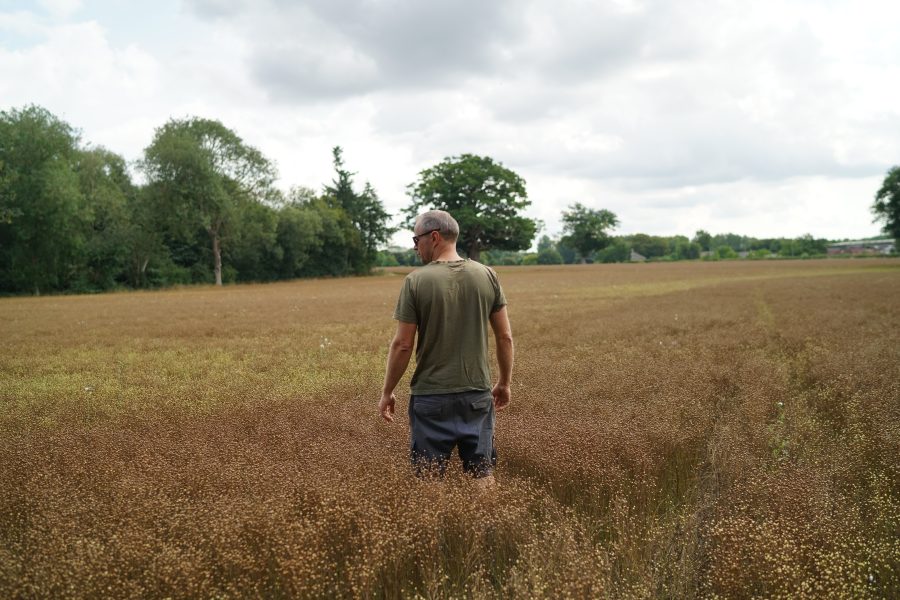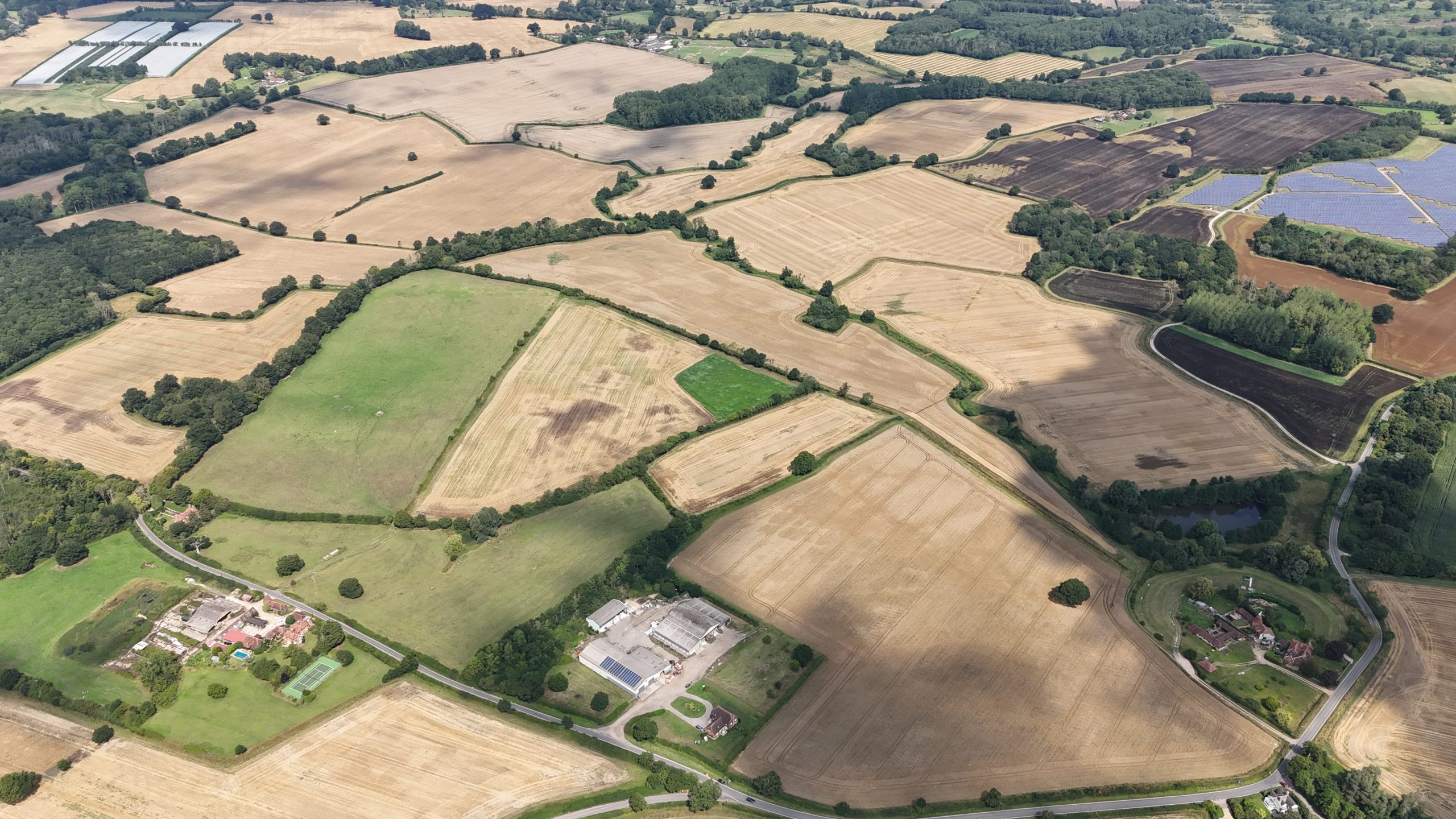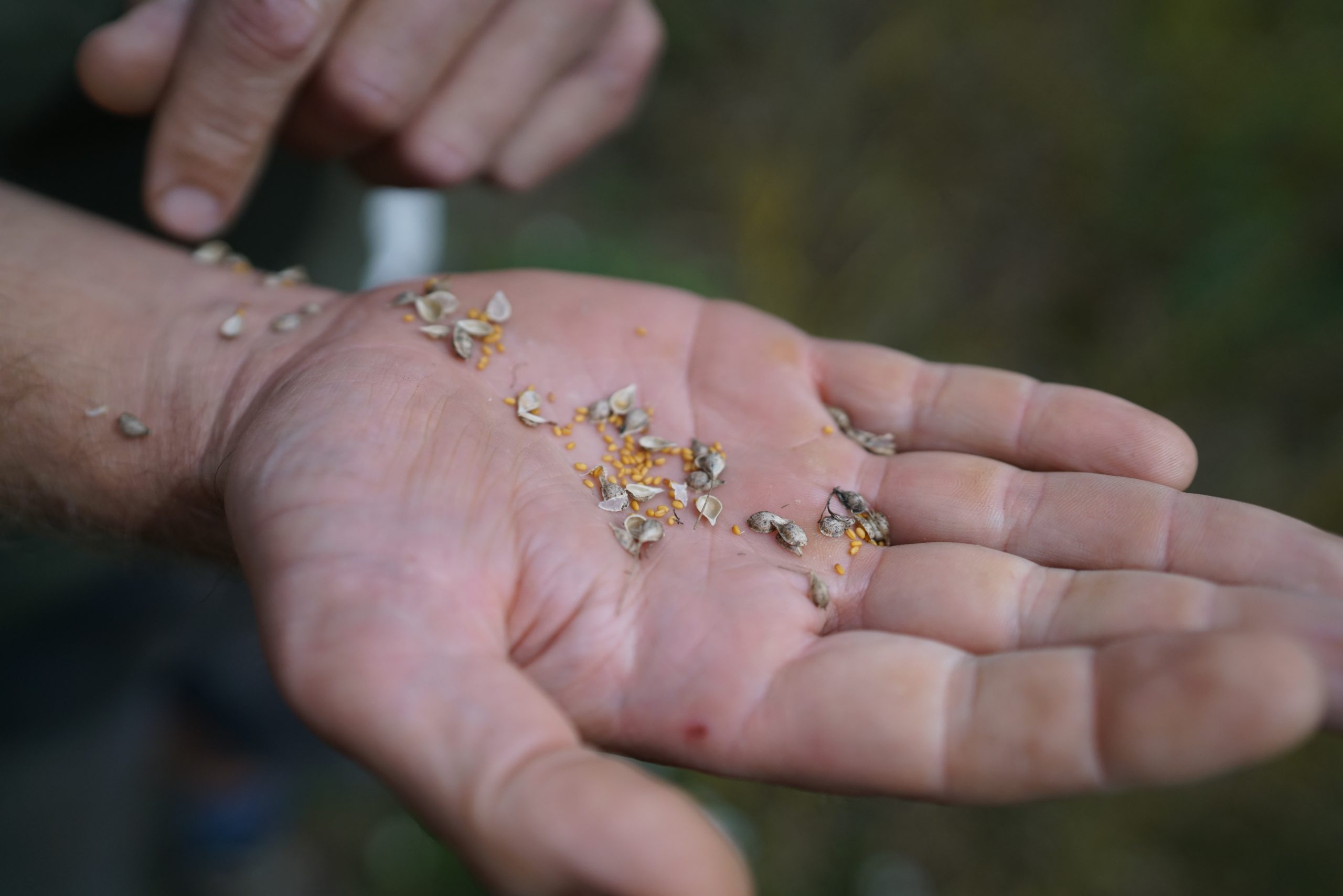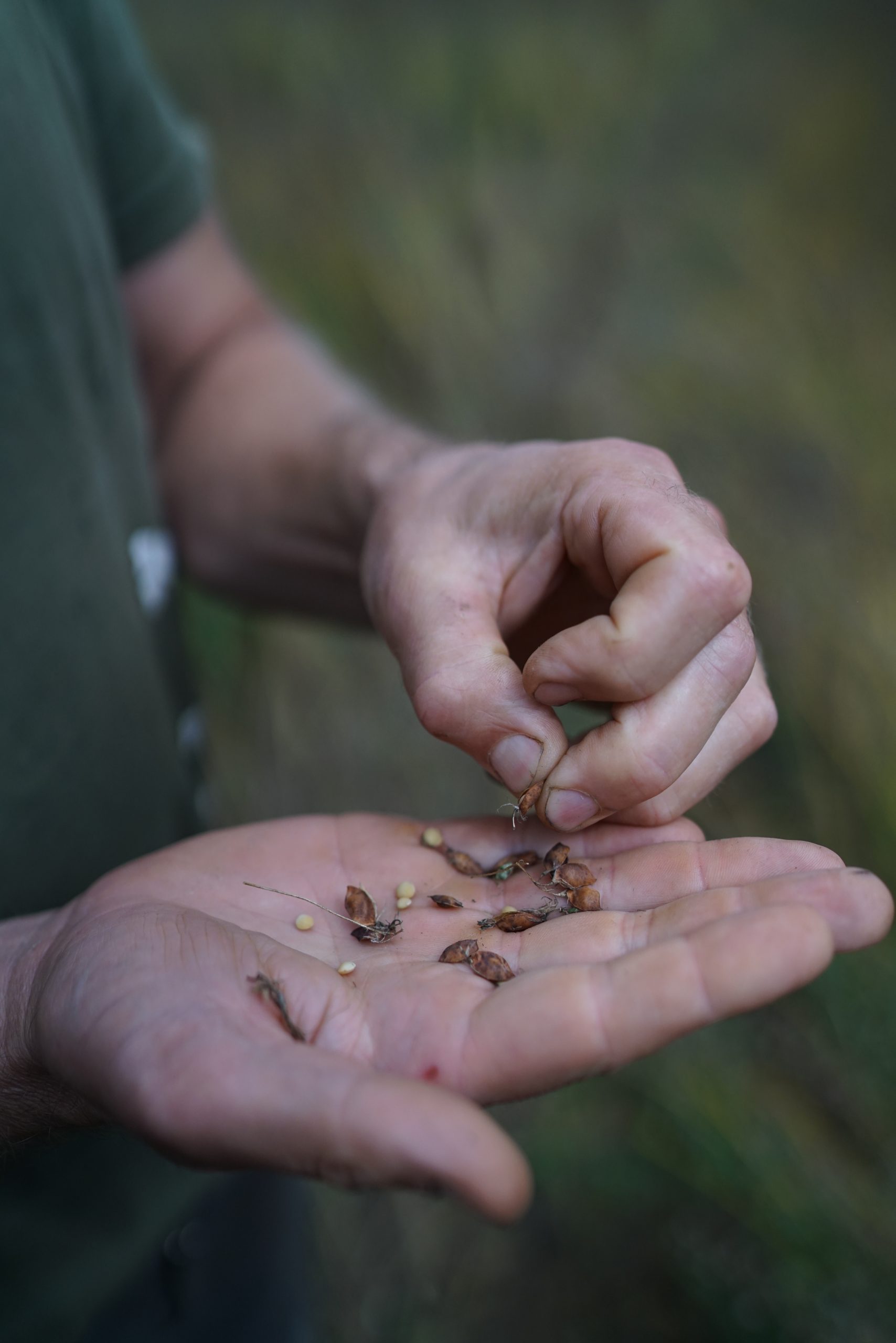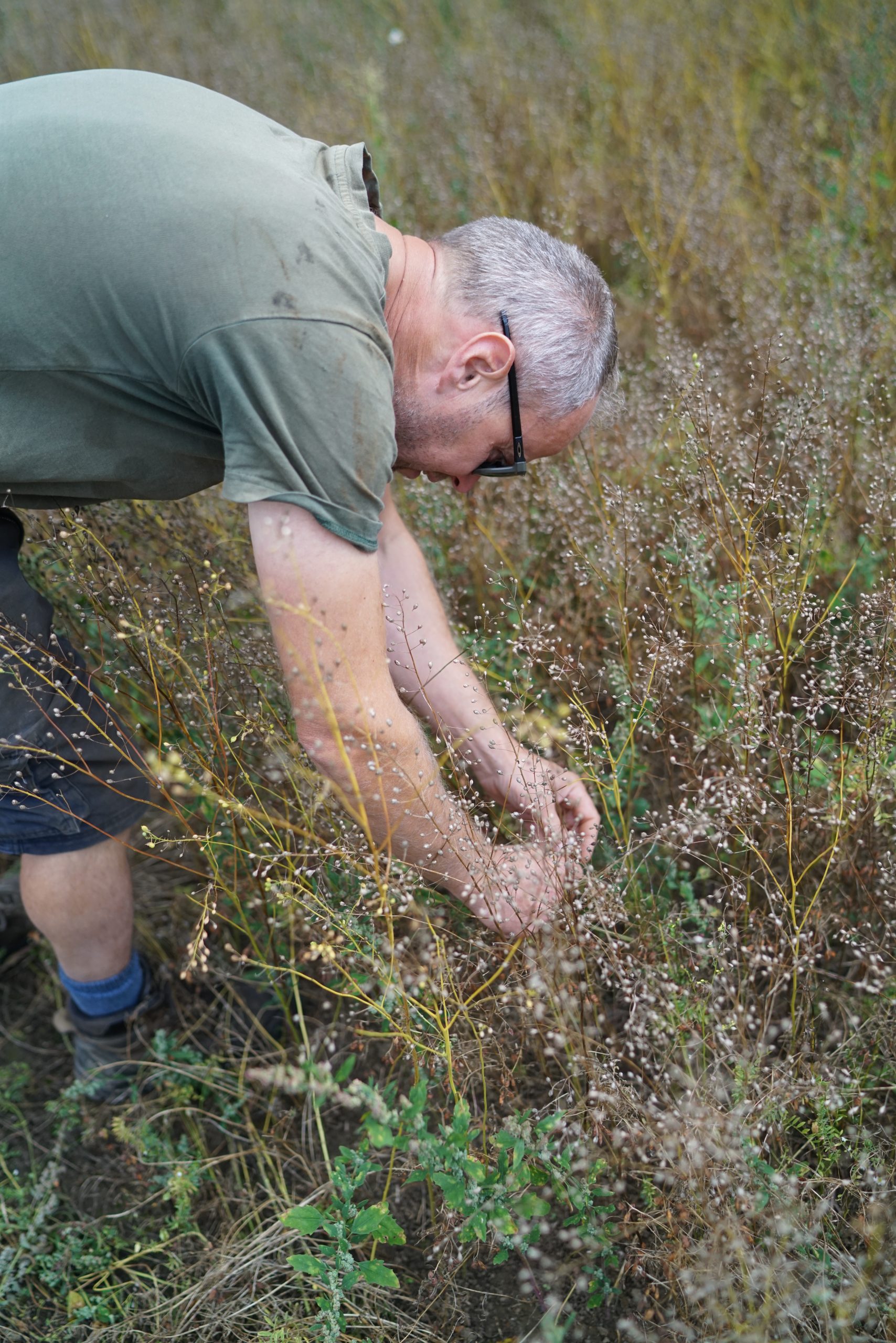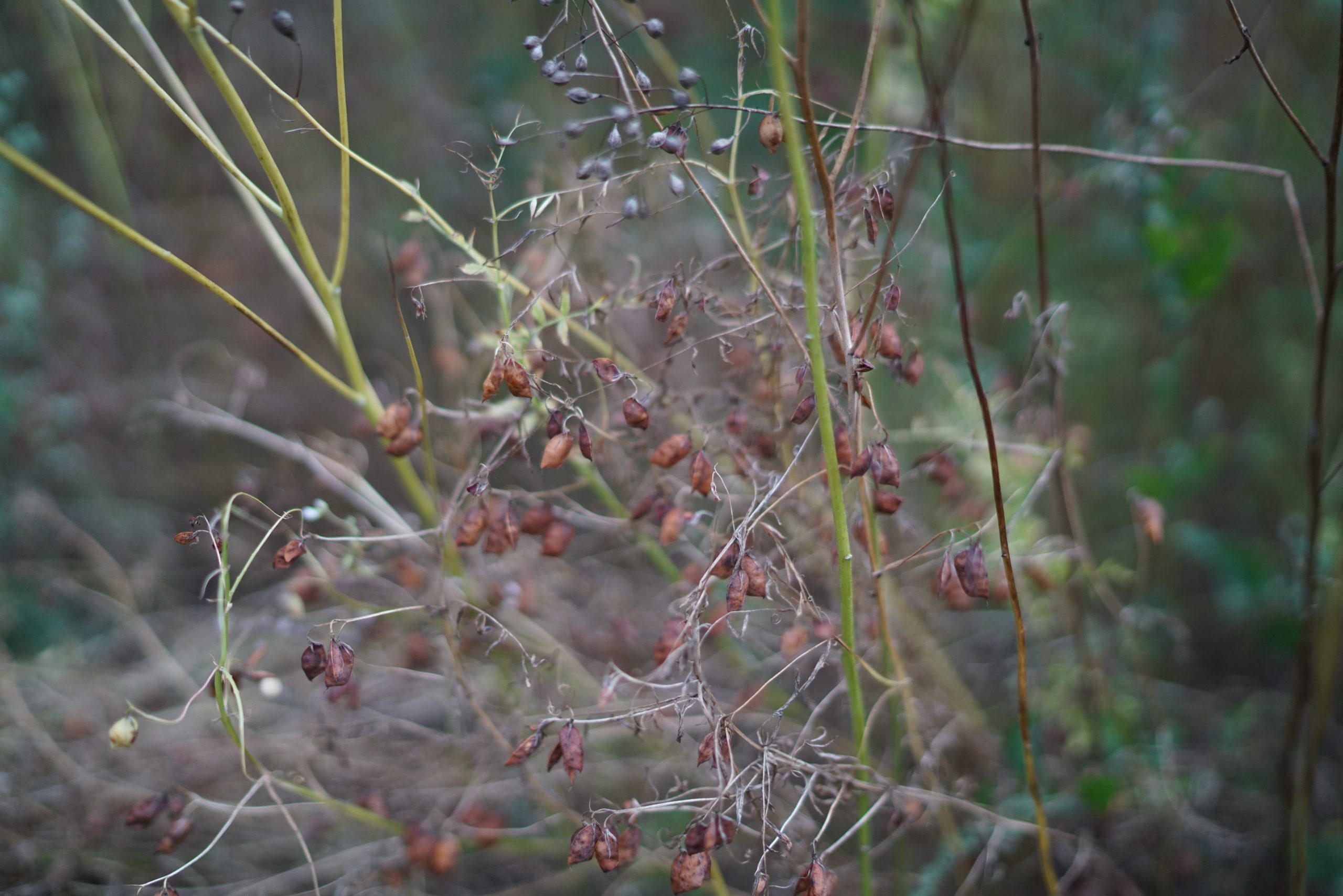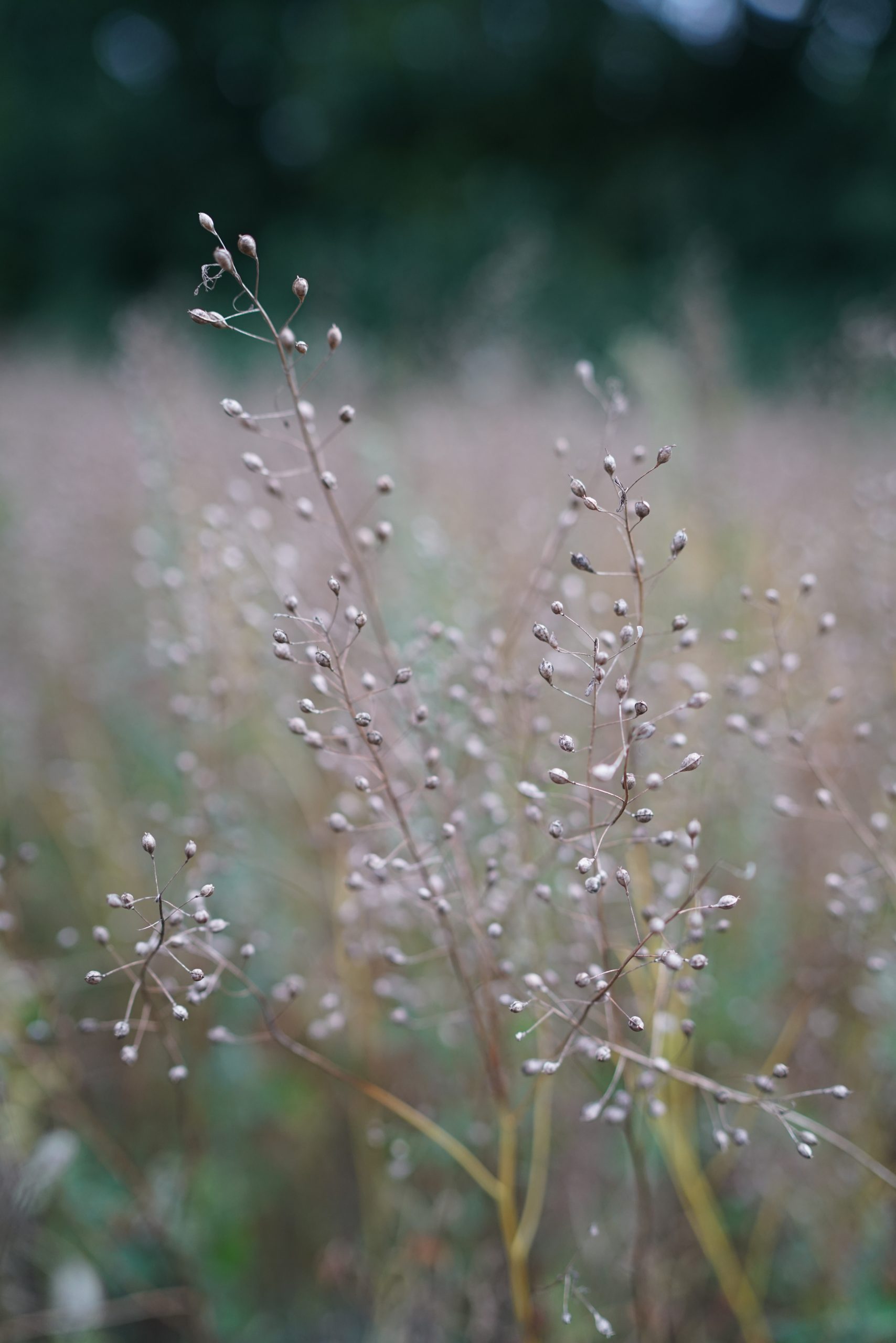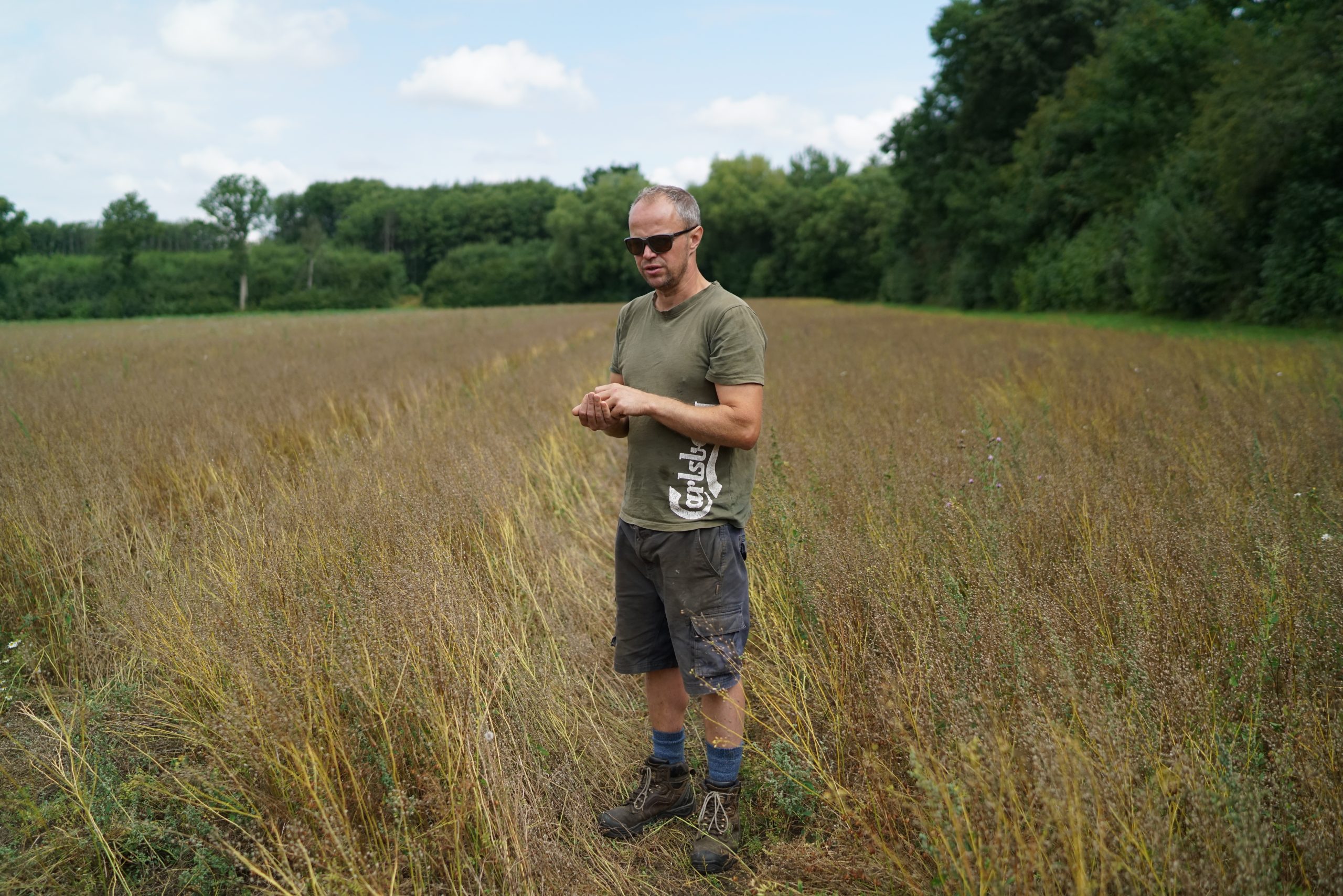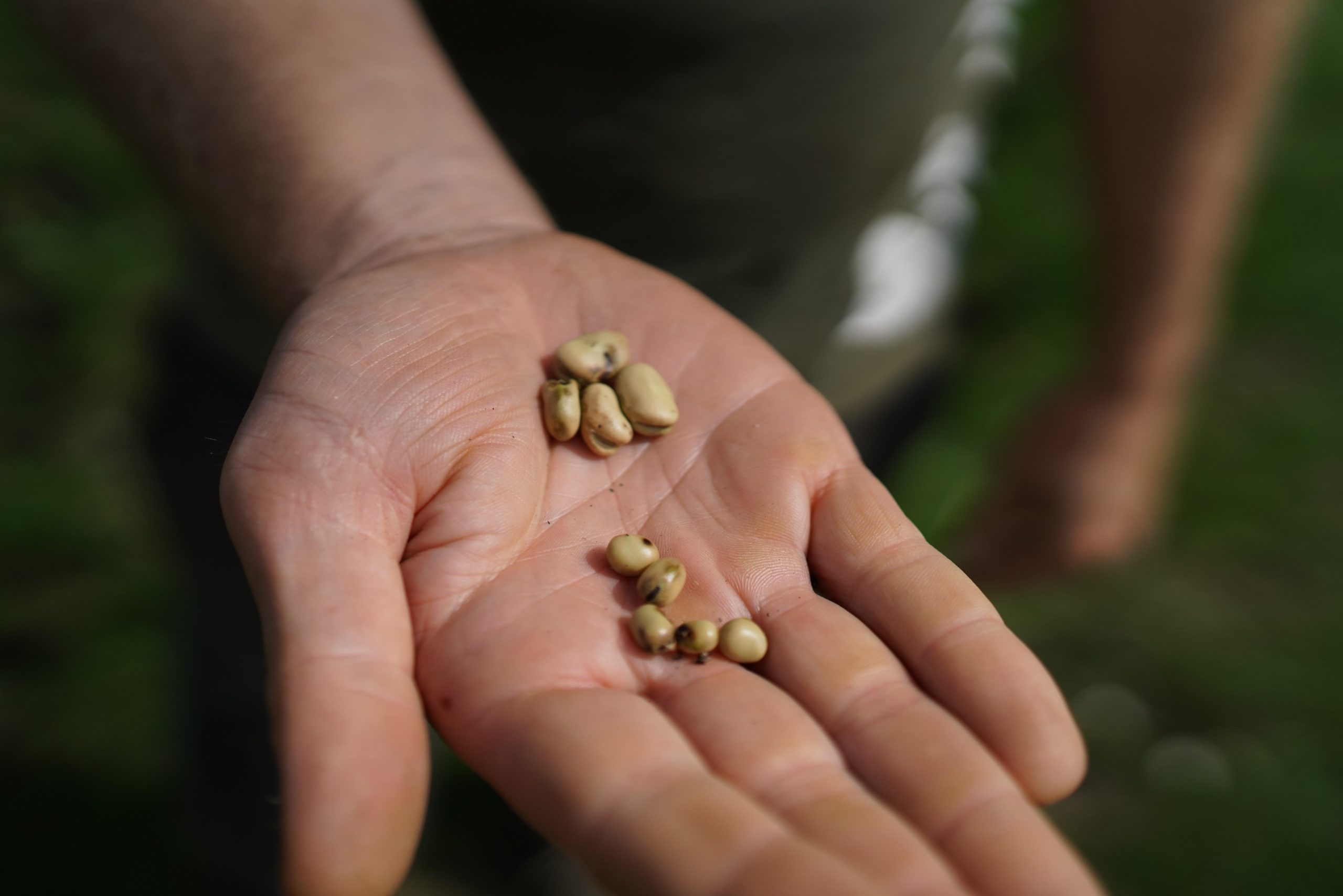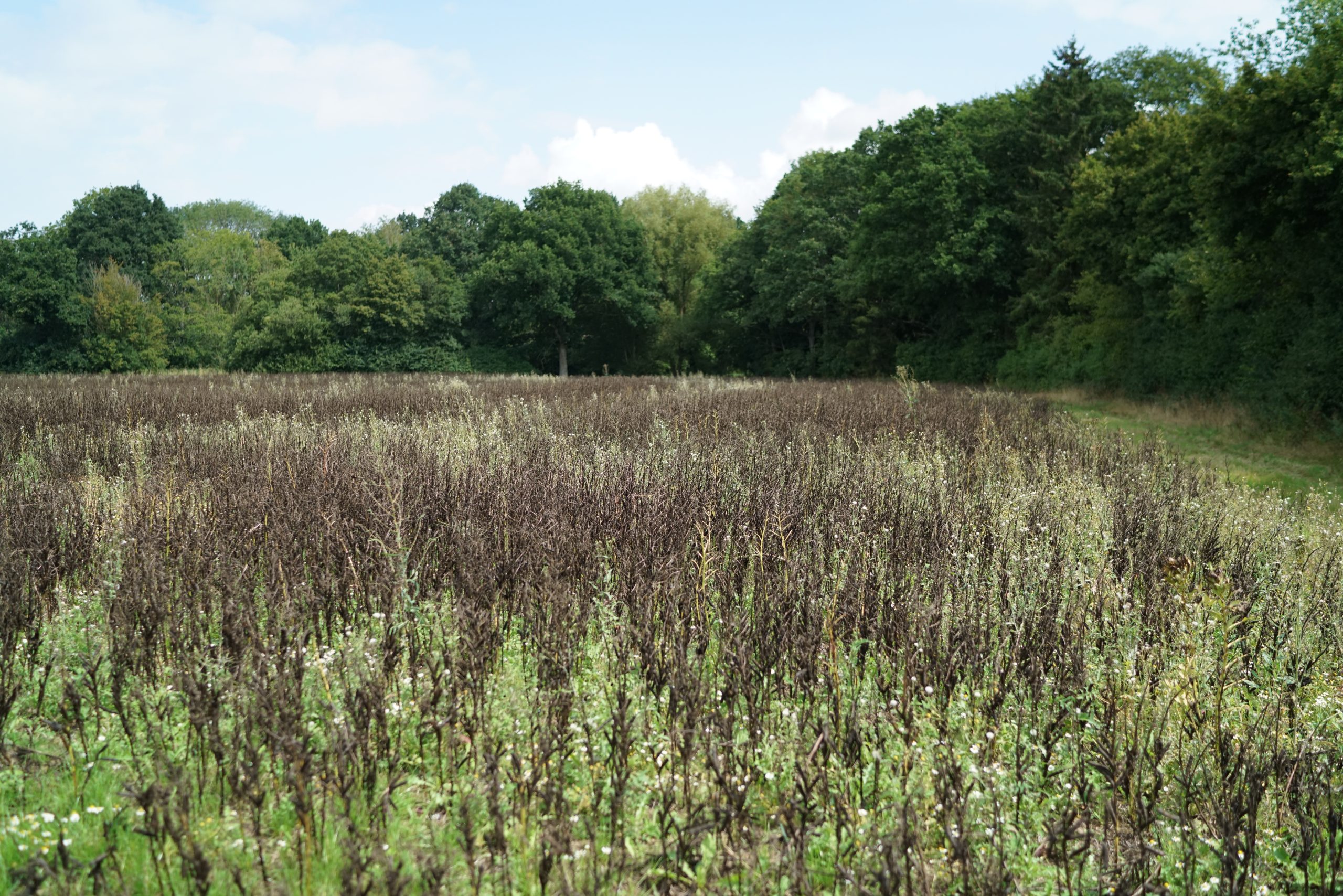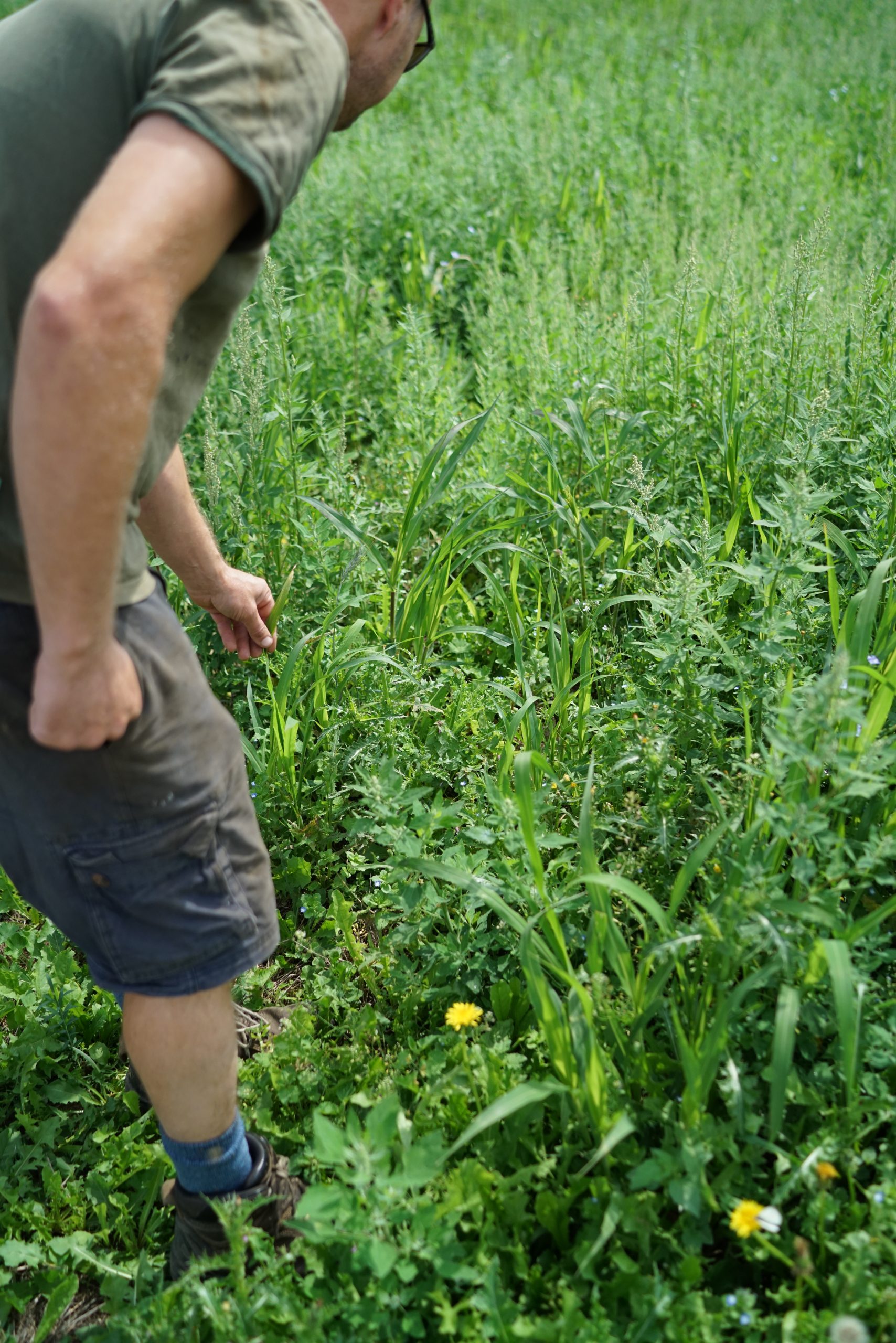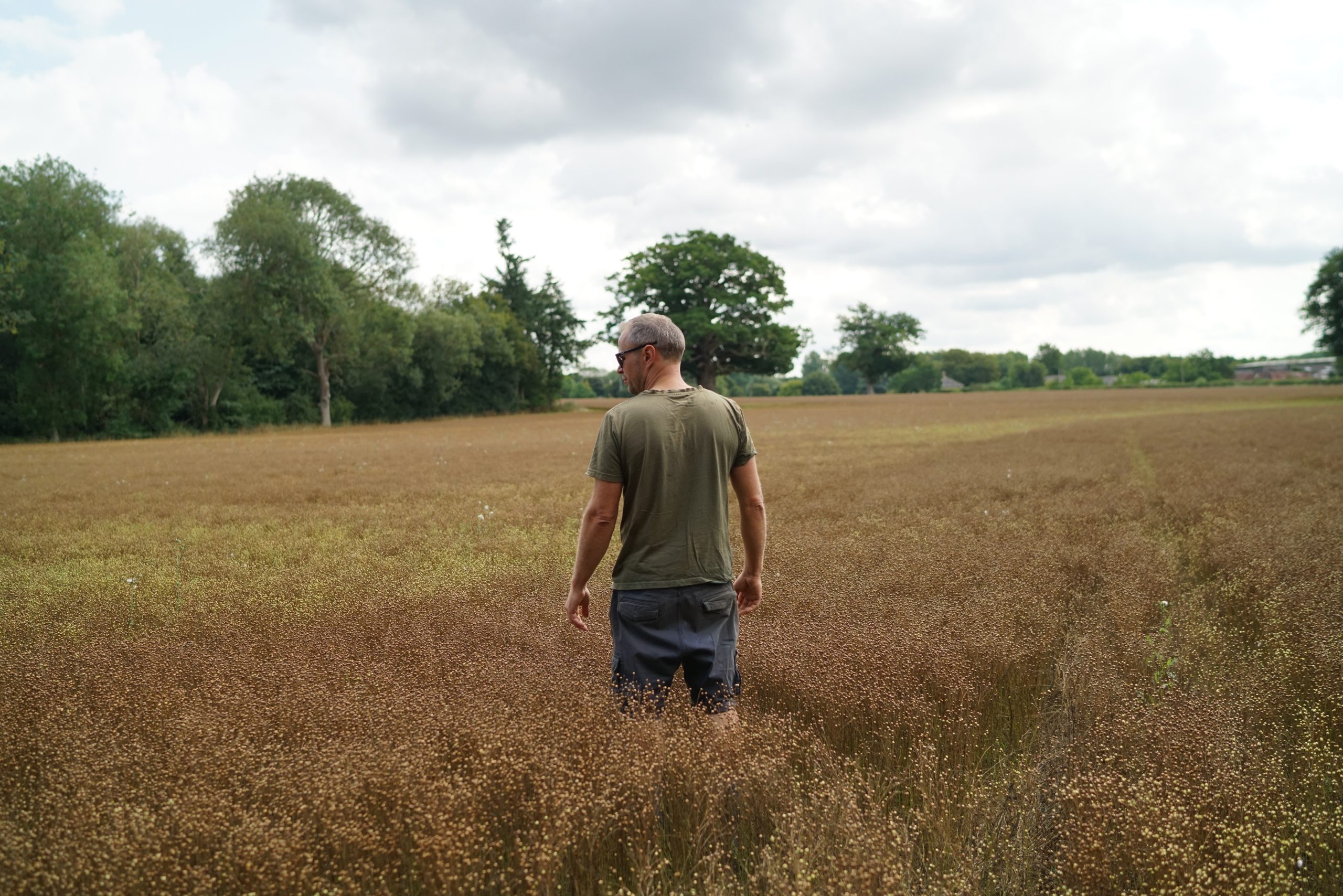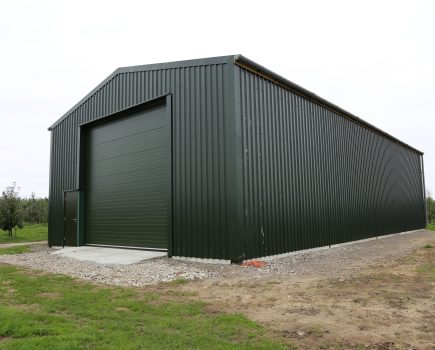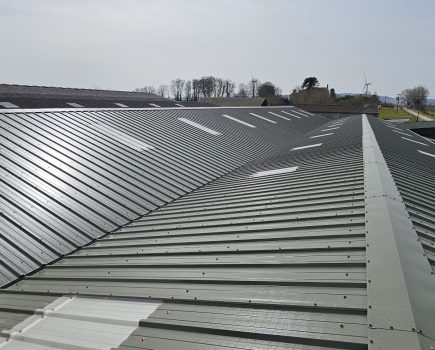Nigel Akehurst visits arable farmer and Nuffield Scholar Andrew Howard at his family farm in Hothfield, Kent who is balancing risk, innovation and tradition.
Farming alongside his parents, Andrew Howard has built on four generations of agricultural heritage while adapting the business to meet modern challenges. From shifting rotations and experimenting with specialist crops like lentils and camelina to intercropping and running on-farm trials, Andrew is combining traditional know-how with innovative approaches to improving resilience, profitability and soil health.
Standing in a field of olive green lentils intercropped with camelina, Andrew Howard bent down and prised open one of the tiny pods, revealing small orange seeds. “Camelina’s used for vegan egg replacement,” he explained. “I sprinkle it on salads – it’s got a slight peppery taste.”
It’s a picture of a farmer thinking beyond commodity wheat, and yet, as our conversation unfolds, it’s clear Andrew’s story is as much about holding the line against economic and climatic headwinds as it is about innovation.
From mixed farming to arable specialism
Over a coffee in the farmhouse kitchen, Andrew explained that he is the fourth generation of his family to farm in Kent. His parents, Peter and Pamela, bought Oaklands Farm in the village of Hothfield, near Ashford, in 1993, moving there in 1997 after building the farmhouse and sheds.
Before that, the family were tenants at Sandyhurst Farm, just four miles away near junction nine of the M20. Like many farms in Kent and Sussex at the time, it was a mixed enterprise. “I remember Dad growing a lot of potatoes in the mid to late eighties,” he recalled.
Although he helped out, farming wasn’t Andrew’s first ambition; sport was his passion. After studying environmental management, he spent a year at the Royal Agricultural University in Cirencester before returning to work with his father in 2003. The farm continued to keep beef cattle alongside arable crops until 2007, when they decided to focus solely on cropping. “I’m not really a livestock person,” he admitted.
Machinery costs
In 2003, they went min-till after much hesitation over buying a £16,000 drill, a big investment at a time when wheat was just £60 a tonne. “You’re talking four or five times that cost these days (for a new drill), and wheat’s only £150 a tonne,” Andrew noted.
Machinery inflation has rocketed in recent years, he said. “We bought a new tractor in 2014, a combine in 2017, forklift and drill in 2018. We certainly can’t afford to go and spend £250k on a new sprayer or £300k on a combine, which is double what we paid in 2017. It’s little wonder a lot of machinery dealers are struggling.” Andrew’s concern is that some farms are over-extending themselves to keep up with the latest kit. “There could be some interesting times ahead,” he said, wryly.
Changing rotations and the crops that pay
Andrew’s rotation is fluid. This year’s line-up includes grass seed, winter wheat, spring wheat, spring linseed, winter beans, spring beans, lentils and a camelina intercrop. Next year will swing heavily towards winter wheat, dictated by rotation needs, with smaller areas of winter beans, spring linseed and winter oilseed rape, which they haven’t grown for 10 years.
Asked about the most profitable crops, he named lentils and camelina, followed by winter milling wheat. “The price of wheat is about £180. Most farms would be struggling to produce it for under £200 a tonne, especially after two poor harvests.”
Like many, Andrew plays a waiting game with sales. “We’ve still got wheat from last year in the barn; it wasn’t worth selling. I’ve sold half of last year’s but we’ll hold some and see what happens. You’re on a roulette wheel and hope it works out, except the wheel’s spinning faster these days, with weather, prices and government policy.”
Dropping grass seed
One casualty of storage limitations is grass seed. “It’s a good crop for the rotation and an early harvest, but not an easy one. We used to send it away for storage, which worked well, but now we can’t find a local store nearby. Without that, it’s not worth the hassle.”
Specialist crops: lentils and camelina
Andrew’s venture into specialist crops began after meeting Hodmedod’s in Suffolk while researching his 2015 Nuffield Scholarship on intercropping. In 2018 he planted three hectares of lentils, initially with linseed for structural support. Later he tried oats, but they reduced yields.
The breakthrough came with camelina, an ancient oilseed also suited to Hodmedod’s premium market. The farm now grows 23 hectares of the intercrop, with both crops harvested together and separated by Hodmedod’s.
“It’s nice seeing my name on the packet at the end. You don’t get that with wheat,” he said dryly. The premium price and low inputs make it appealing, though broadleaf weed control is tricky.
“You’re relying on crop competition and a quick start; it’s only in the ground 90 to 100 days.
“If you can get it to harvest, it could be the only crop making a profit this year,” he added. Still, specialist crops carry risk. “We did seed hemp 20 years ago and the company went bust after harvest.”
Intercropping and companion cropping
Andrew’s Nuffield study on intercropping still draws interest. He’s trialling combinations like winter beans with winter peas, and uses oats with linseed to deter flax flea beetle. “It doesn’t cost much and seems to reduce pest pressure,” he said. “That’s the appeal; reducing agronomy costs while integrating pest management.” His drill’s twin hoppers make companion planting straightforward. “It’s not a silver bullet, but it’s another tool in the box.”
Weather extremes and soil health
I asked how his no-tillage cultivation methods had improved the farm’s soils over the years.
“I inherited healthy soils from my father’s mixed farming,” he explained, “but the past five years have been punishing. Heavy rain for months on end has set us back. We’ve had to buy a low disturbance subsoiler and a mole plough to deal with compaction. In 2019 I’d have given you a different answer. I was more rigid and evangelical. Now we have to be more flexible.”
Blackgrass is kept in check by spot-spraying before it seeds, though herbicide resistance remains an ongoing battle. “The days of spring herbicides working for blackgrass are over; you may as well burn £50 notes,” he said dryly.
Trials, drones and AI
Andrew is also trialling compost extract with Kent Wildlife Trust (KWT), after being approached by KWT’s Rory Harding, who had heard him speak about his own experiments and secured Co-operative Foundation funding to trial the idea.
The principle is simple: take a biologically rich compost – in this case, produced on farm using a Johnson-Su bioreactor – and brew it into a liquid ‘extract’ that can be applied directly with the seed at drilling. The aim is to coat the seed with beneficial microbes, giving it a head start in rooting and resilience.
“Last year we saw an increase in yield of about 0.4 tonnes a hectare in winter wheat, which is significant,” he said. “We’ve just harvested this year’s trial and are waiting on the results.”
The benefits, he believes, are two-fold. Firstly, stronger rooting in the early stages allows the plant to cope better with weather extremes, whether that’s a wet spring or a dry spell. Secondly, it could potentially reduce nitrogen use.
“It’s one of those things that feels like it should be good, but it’s an extra layer at drilling, so it needs to show a benefit. Otherwise, it’s not worth the hassle,” he said. Andrew is quick to temper expectations. “Like a lot of biological products, some years they work well, some years you don’t see any response. The weather is key; a dry or wet spring can change everything.”
The trials are now in their second year, with fellow Kent farmer Andrew Lingham also taking part to test how results vary across different soils and systems.
For Andrew, the appeal is partly practical. “The good thing about compost extract is that it’s cheap. I can make it myself. I’m not paying anyone for a product; it’s just time and hassle. If it works, it’s something any farmer could adopt.”
Tax, succession, SFI and solar
Heading out in Andrew’s pickup truck to take some photographs, our conversation turned to succession, particularly in light of recent proposed changes to agricultural property relief (APR) and business property relief (BPR).
“We thought we were sorted pre-October budget, but we’re waiting to hear back from the tax advisor about the changes,” he said. “Dad’s 78, Mum’s 74. You don’t feel like investing very much in anything when the future’s uncertain; it’s another reason machinery dealers are struggling and confidence levels are on the floor.”
He credits the SFI 23 scheme and an 11-hectare solar farm (installed in 2014) with providing some stability. Stopping to take a couple of photos, he remarked with a smile: “It’s our best-paying field.”
He’s aware, however, that solar farms divide opinion. “One of the reasons our original application was turned down was because there was a small patch of grade 2 land in the field,” he said. “That’s fair enough; one of people’s big bugbears is putting solar farms on the best, most productive land.”
But Andrew believes context matters. “If it’s grade 3 or worse, you can’t blame farmers for looking at it. Especially when food production doesn’t always pay, you need other ways to make the business viable.”
Frustrations with the market
The conversation moves onto commodity markets, and his frustration is palpable. “Last year was the worst harvest in a generation and the price went down because they imported grain from Germany. That’s why there’s millions of tonnes of last year’s wheat still in sheds; the millers screwed us over.”
Labour crisis, farm sizes and staying optimistic
Back in the yard, I start packing up my photography gear and talk turns to staffing, which is another major worry for Andrew. At present, the only regular labour on the farm is provided by himself and his father, Peter. “Dad keeps himself busy, doing jobs,” said Andrew. “But, realistically, we’ll have to employ someone at some point.”
The challenge is finding the right person — and affording them. “The income just isn’t there to pay a full-time wage,” he explained. “I’d have to go and find another job for half the time to employ someone to do the job that I can do. Or do you try and do the whole job by yourself and just have someone in for harvest?”
Andrew sees this as part of a wider structural issue. “A lot of family farms are in the same position. Either you stretch yourself thin doing it all or you take on staff you can’t really afford. It’s one of those problems without an easy answer.”
Looking ahead, he questions the trend towards ever-larger farms run by contractors. “They want the whole farm in one crop, and the countryside becomes less diverse. I’m not convinced it works. Even the big boys (who don’t have any housing money behind them) are struggling. One farmer I visited up in Nottinghamshire a few years ago was doing about 5,000 acres (seven times their acreage) on mostly rented ground, turnover just double ours, with huge machinery costs. It doesn’t add up.”
For now, he draws motivation from the crops that work, the satisfaction of harvesting a tricky intercrop and the small wins from trials and market premiums. “Farming’s never been easy,” he reflected, “but there’s still a lot to be excited about if you’re willing to adapt.”
Farm facts
- Farm size: 750 acres, mix of owned and rented
- Main crops: Winter wheat, spring linseed, winter beans, lentils/camelina intercrop
- Schemes: SFI 23 + Countryside Stewardship
- Diversification: 11ha solar farm, specialist crops like lentils/camelina
- On farm trials: Various, including Kent Wildlife Trust compost extract
- Award: BBC Food & Farming “Farm for the Future” winner, 2024
- default
- Camelina seed
- Andrew looking at camelina/lentil crop
- Lentils and camelina intercrop
- Camelina/lentils
- Andrew Howard
- Spring beans for companion crop seed
- Spring beans
- Game cover
- Andrew in a field of Linseed
- Camelina seed
For more like this, sign up for the FREE South East Farmer e-newsletter here and receive all the latest farming news, reviews and insight straight to your inbox.

